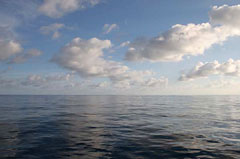Journals 2007/2008
Heather Judkins
Seminole High School, Seminole, FL
November 24, 2007
Talking Beaufort
While the observers are working on the flying bridge, there are many conditions that they monitor throughout the day. They monitor sun position, amount of haze over the water, wind direction, wind speed, and the sea state.
The Beaufort scale measures the affect of wind on the water. It does not take into account swell height. The scale ranges from 0-12 with a 0 Beaufort meaning the seas look like glass and a 12 Beaufort meaning the air is filled with foam and spray with wind speeds at hurricane strength. Many of our days for this leg have been between a Beaufort 2-3. A Beaufort 3 is when you can see occasional crests breaking on the water.
This scale is important to the observers in terms of seeing the animals they are looking for. When I was using the big-eyes with a Beaufort 2 or 3, it was not difficult to see to the horizon. However, when the Beaufort went up to a 4, it was much more difficult to see the animals because of the waves cresting. Many times, observers will look for queues to spot the animals; whether it be a flock of birds or splashes in the water. With a higher Beaufort, it became difficult to spot the mammals at a distance.
 
Profile:
Captain Greg Hubner, McArthur II
Greg has been with NOAA for well over 20 years and this is his third season as captain of the McArthur II. He is ultimately responsible for everything that occurs on board- overseeing daily operations, navigating, piloting, weather monitoring, and daily communication with the chief scientist. He is one of only two captains that are currently working on a NOAA vessel that is not a NOAA Corps officer. He started in the Navy before making the move to NOAA. He has been promoted through the various positions on board before becoming a captain. Along the way, he was also a divemaster for 10 years and worked in Prince William Sound after the Exxon Valdez oil spill, placing objects in the seafloor to encourage the aggregation of larval animals. He says the most challenging thing aboard the McArthur II is to contend with is tedium. His goal is to keep everyone focused on their jobs and maintain the safety of everyone on board as they go through their daily operations.
The most rewarding part of his job is that he "likes what he does." If people are getting up and dreading going to work, why go? I have heard that from many here on the ship. One has to enjoy this way of life at sea to make it a successful career. The other rewarding part of his job is to see the variety of people that come onboard and the projects that are accomplished. The one-man submersible and ROV projects that have been on the ship have been ones that stick out in his mind. Many projects are repeated and he gets the chance to reunite with many of the scientists that he has met on previous cruises.
Marine Science Questions:
1. Using the pictures, what do you think the Beaufort is for each one? Why?
2. If you could be a captain of a ship, where would you want to be located in the world and what type of projects would you like to have onboard? (Remember, you are with ship for the entire year, every year)
|




